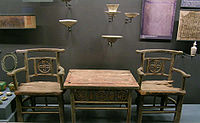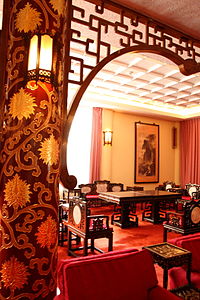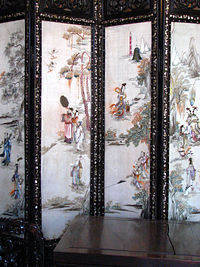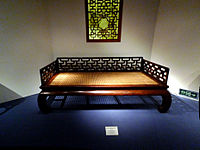- Chinese furniture
-
A complete set of Ming Dynasty furniture at the Shanghai Museum

 Furniture made during the Liao Dynasty, excavated from the underground palace in Tian Kai Ta, in Fangshan District of Beijing
Furniture made during the Liao Dynasty, excavated from the underground palace in Tian Kai Ta, in Fangshan District of Beijing
The forms of Chinese furniture evolved along three distinct lineages which dates back to 1000 BC,[1] based on frame and panel, yoke and rack (based on post and rail seen in architecture) and bamboo construction techniques. Chinese home furniture evolved independently of Western furniture into many similar forms including chairs, tables, stools, cabinets, beds and sofas.
Chinese furniture includes Chinese antique furniture and Chinese classic furniture, usually, the former is made in softwood and the latter is made in hardwood.
Contents
Cultural Context
What is now considered the Chinese aesthetic had its origins in China as far back as 1500-1000 BC. The furniture present in some of the artwork from that early period shows woven mats on elevated floors, sometimes accompanied by arm rests, providing seating accompanied by low tables. In this early period both unadorned and intricately engraved and painted pieces were already developing.
Buddhism, entering China around AD 200, brought with it the idea of (the Buddha) sitting upon a raised platform instead of simply mats. The platform was adopted as an honorific seat for special guests and dignitaries or officials. Longer versions were then used for reclining as well, which eventually evolved into the bed and daybed. Taller versions evolved into higher tables as well. The folding stool also proliferated similarly, after it was adapted from designs developed by nomadic tribes to the North and West, who used them for both their convenience and light weight in many applications such as mounting horses. Later, woven hourglass-shaped stools evolved; a design still in use today throughout China.
Some of the styles now widely regarded as Chinese began appearing more prominently in the Tang Dynasty (618-907 AD). It is here that evidence of early versions of the round and yoke back chairs are found, generally used by the elite. By the next two Dynasties (the Northern and Southern Song) the use of varying types of furniture, including chairs, benches, and stools was common throughout Chinese society. Two particular developments were recessed legs and waisted tables. Newer and more complex designs were generally limited to official and higher class use.
It was from this basis that more modern Chinese furniture developed its distinguishing characteristics. Use of thick lacquer finish and detailed engravings and paintings as well as pragmatic design elements would continue to flourish. Significant foreign design influence would not be felt until increased contact with the West began in the 19th century, due to efforts on the part of the ruling elite to limit trade.
During the Ming and Qing dynasties previous bans on imports were lifted, allowing for larger quantities and varieties of woods to flood in from other parts of Asia. The use of denser wood led to much finer work, including more elaborate joinery.
Four Categories
Chinese furniture is traditionally consisted of four distinct categories, all formed by the mid Qing dynasty, but each with its own unique characteristics.[2]
- Beijing category (京式家具): characterized by its simple built, directly developed from Ming Dynasty furnitures.
- Guangzhou category (广式家具): incorporate western influence, formed in the 19th century. Characterized by the adoptation of the decrorative mounting of marble and shells of shellfish.
- Shanghai category (海式家具): characterized by its decrorative sculpture and sculptured paint.
- Suzhou category (苏式家具): Opposite to Beijing category, characterized by its elaborate decroration, developed from early Qing Dynasty furnitures.
Construction
 Chinese furniture in Taipei's Zhongshan Building
Chinese furniture in Taipei's Zhongshan Building
Platform construction is based on box designs and uses frame-and-panel construction in simple form during earlier periods evolving into more and more modified forms in later periods. While earlier pieces show full frame-and-panel construction techniques, different parts of the construction were modified through the centuries to produce diverse looking pieces which still share the same basic construction. First the panel, originally complete, is subject to cut-out sections, followed by further reduction to what may appear to be simply decorative brackets. Further refinement of the same pattern lead the shape of the decorative brackets being incorporated into the shape of the surrounding frame and simultaneously the two mitered vertical pieces comprising a corner become one solid piece. Pieces start to have small cross-pieces attached to the bottom of the feet rather than a frame that is equal on all sides and finally, with evolution of the complex woodworking joints that allow it, the cross-pieces are removed entirely, leaving a modern table with 3-way mitered corners. Unlike European-derived styles, table designs based on this style will nearly always contain a frame-in-panel top, the panel serving as the tabletop center and the frame sometimes also serving as what would be rails on a European table. Cabinets in this style have a top that does not protrude beyond the sides or front. The critical element in almost all pieces of this type is the mitered joints, especially the 3-way mitered joining of the leg and two horizontal pieces at each corner.
The Yoke and Rack construction differs critically in the way that the legs of the piece are joined to the horizontal portion (be it tabletop, seat or cabinet carcass) using a type of wedged mortise-and-tendon joint where the end grain of the leg is visible as a circle in the frame of the tabletop. The cross-pieces (stretchers in the western equivalent) are joined through mortise-and-tendon joinery as well. The legs and stretchers are commonly round rather than square or curvilinear. The simplest pieces are simply four splayed legs attached to a solid top, but more complicated pieces contain decorative brackets, drawers and metal latches. Cabinets in this style typically have an overhanging top similar to western-style cabinetry.
Bamboo construction style, although historically rooted in pieces made from bamboo, later saw many pieces made from hardwood with patterning to imitate the look of bamboo, or simply in the style of previous pieces made from bamboo. The construction is more similar to the Yoke and Rack style with some apparent crossover.
References
- ^ Ecke, G. "Chinese Domestic Furniture in Photographs and Measured Drawings" pp. XV-XXXIII, Dover Publications, Inc., 1986
- ^ Traditional Categories of Chinese furnitures
External links
- Oriental collectible antiques at the Open Directory Project
- Herbert Offen Research Collection An excellent bibliography of publicly accessible books and manuscripts on Chinese furniture.
Categories:- Furniture
- History of furniture
- Arts in China
Wikimedia Foundation. 2010.



